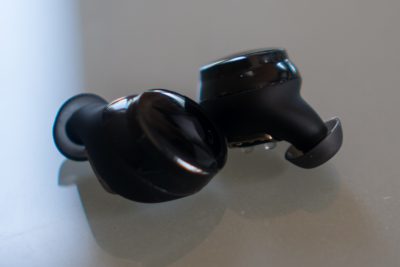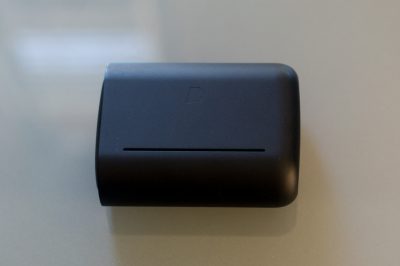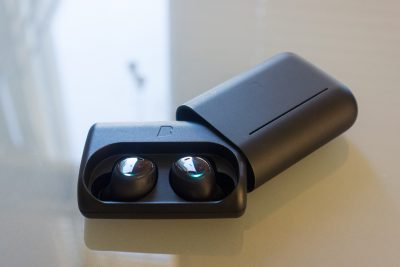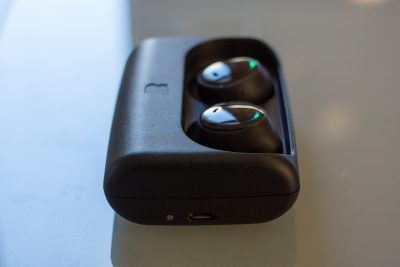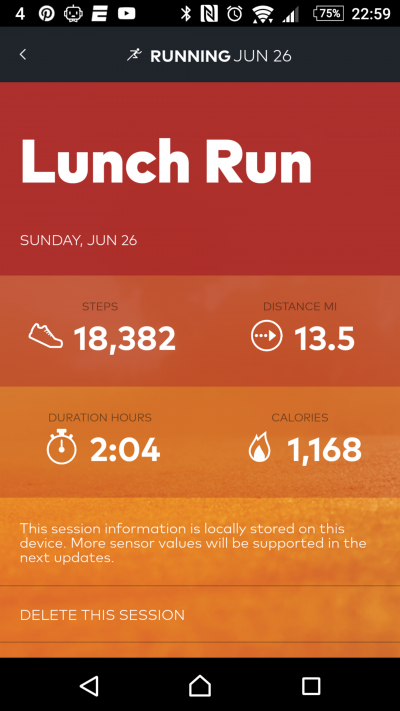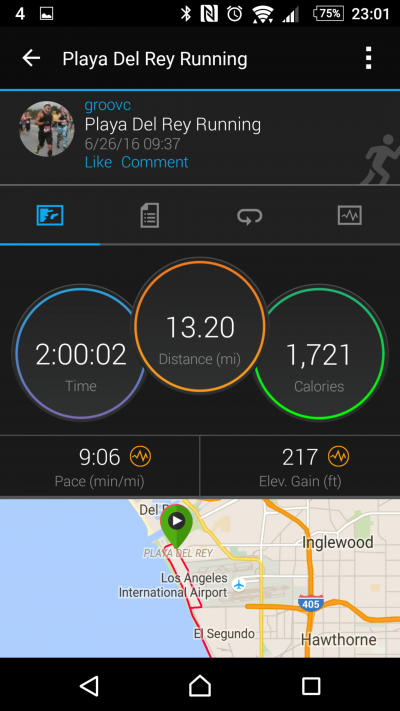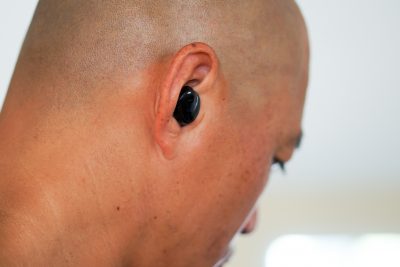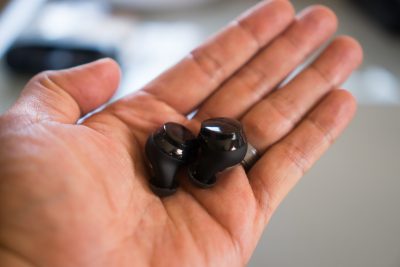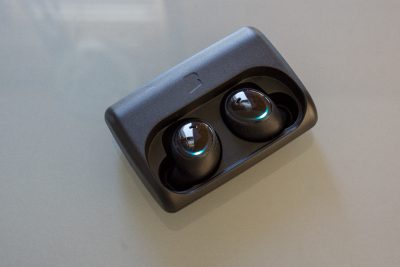
Bragi Dash Review
Introduction
For the longest time, I've preferred to run as unencumbered as possible. I just want to be able to put on my running shoes, start my trusty Garmin watch, and head out the door.
Of course, there are times when audio distraction is nice to have especially on long slow days. This complicates getting out the door fast because this means I need to bring my phone, something to carry my phone in, and a pair of earphones that can survive the power of my perspiration and not annoy me with its microphonics (that annoying sound you hear when a cord bounces against your body or clothes). So, with this in mind, I started looking for a better solution...
Back in February 2014, while browsing Kickstarter, I came across "The Dash" by Bragi, a super ambitious project to build a pair of Bluetooth wireless earphones that could also track you using various sensors. The Dash promised many features with initial specifications that were mind blowing. I quickly backed the project and awaited its arrival in late 2014.
It was delayed. Like really delayed. Like 17 months delayed.
It was so delayed that I even considered picking up other earphones instead...however, I decided to wait it out and finally they arrived in the middle of March 2016. I've been using them for the past several months with the various improvements from firmware 1.22 to the latest 1.51 and ready to share my impressions.
Quick Take
In short, the Bragi Dash are a pair of completely wireless in-ear headphones. In addition to playing music from the built-in memory, they can play audio from Bluetooth connected devices like mobile phones and laptop computers. They can also be used as a Bluetooth headset so you can take calls. Because they're waterproof, you can get sweaty with them and even go swimming with them. Finally, with the numerous integrated sensors, they can reasonably detect steps, distance, and heart rate measurements.
You probably want to know, "Should I buy one?" I'm going to answer this from a runner's point of view and list out highlight features based on my use cases.
- You want to run and listen to 4GB of music without dealing with wires
- You don't mind loading music/podcasts onto the internal storage
- You don't need more than 3 hours of audio playback
- You also want to listen to music while cycling, swimming and cross-training
- You want occasional activity tracking
- You want pretty good sound isolation
- You want the ability to be aware of your surroundings
- You are OK with occasional Bluetooth drop outs if you're streaming music
If that sounds like you then you will likely enjoy owning and using the Bragi Dash. In its current state, The Dash offers solid standalone MP3 player functionality, decent Bluetooth streaming, basic activity tracking, and a lot of promise. Ultimately, you'll have to decide at the current price ($299 USD) if the convenience is enough and you're willing to wait for that untapped potential with their frequent updates.
With that out of the way, let's delve deeper into what you can do with the Bragi Dash and how it holds up to the promise of being Wireless Smart In Ear Headphones and the ability to listen, track and communicate.
Build Quality
For a first generation product, the build quality and fit and finish of the Dash is admirable.
Each side is comprised of an earbud with a sleeve which has the ear tip connected. The XS size is basically just the ear tip portion. Interestingly, the S, M, and L sizes add extra material to cover most of each ear bud to give a tighter fit but the ear tips are basically the same size.
The included anodized aluminum case for the Dash is both for protection and for charging. It's wonderfully solid and can charge the Dash up to five times. It uses a standard microUSB for charging and for connecting to your computer. It has a small LED that displays red, orange or green to indicate it's charged status. There's also a slide cover that has a tasteful and function slit so you can see the charge status of the Dash. Finally, it has a small pin-hole that's used to reset your Dash should they freeze for any reason or to put them in a deep sleep mode.
How the Dash Works
Running with the Dash is super easy. You simply put them in your ears, wait to hear a connection chime, and then you're ready to go. The left Dash controls activities and toggling audio transparency. The right Dash controls music playlists, music playback, and volume.
For each Dash, the controls are either taps, swipes or long presses. Here's a quick breakdown of the controls.
The Left Dash
- Tap - Start/Stop activity
- Double Tap - Skip to next
- Triple Tap - Skip to previous
- Swipe (Forward/Backward) - Toggle audio transparency
- Long press - Activity Mode
- Longer Press - Connect to phone via Bluetooth Smart
The Right Dash
- Tap - Start/Stop audio playback
- Double Tap - Skip to next
- Triple Tap - Skip to previous
- Swipe (Forward/Backward) - Volume control
- Long Press - Change audio playlist
The controls took me a few days to figure out. The taps are the trickiest to figure out since they require a specific rhythm to be recognized. It's actually pretty straightforward if you're stationary but it takes a little more practice if your body is in motion. I have pretty much mastered the controls. The only one that occasionally trips me up is a triple tap.
Running with the Dash
For the past several months, I have been testing the Dash on runs from about 3 to 15 miles (5K to 23K) along with my trusty Garmin Fenix 3 and a Heart Rate Monitor chest strap for comparison when testing the activity tracking.
I tested what I consider the most common scenarios for most runners:
- The Dash as a standalone MP3 player
- The Dash tracking activity and playing music
- The Dash Streaming music from a mobile phone
Scenario 1: Standalone MP3 Player
This is my most frequent use case and I'm happy to report that the Dash work nearly flawlessly in this regard. I literally pop them into my ears, head out the door, tap once to start my music, and then start my run. So easy.
The 4GB of built-in memory holds around 1000 songs which can be manually copied over from a computer. When connected to a computer, the Dash acts as an external USB drive. There are four predefined folders which are essentially playlists. One only has to drag and drop files over to each folder in order to build playlists.
I've only had 3 occasions where something went wrong. In all cases, the left Dash stopped transmitting but I could still hear music out of the right Dash. Not great but not terrible either. It also seems that the latest firmware version 1.5.1 seems to have largely solved this issue. On the last occurrence, the left Dash actually did end up recovering but about 7 miles later into my run.
When using the Dash like this, the battery has lasted for at least 2 hours 45 minutes of activity. The Dash will warn you periodically that its battery is low before it shuts itself off. My observation is that you have anywhere from 15 to 25 minutes left once you start hearing the low battery message.
Scenario 2: Tracking Activity and Playing Music
My second most typical use case has me tracking activity while playing music from the internal memory. This is for those days when I don't feel like wearing my chest strap but would still like to get an approximate average heart rate. Again, I can get going pretty quickly by just putting them in my ears, starting the activity, and then starting my run.
During the run, the Dash will notify you of the duration, number of steps and current heart rate every 5 minutes. Anecdotally, the current heart rate has been either within a few beats within my Garmin chest strap's reading or wildly off (like telling me my heart rate is 240+ bpm).
At the end of a run, you can tap the left Dash to end the activity or use the Bragi app to end the activity if you're connected to your phone. Either way, the Dash will read you the duration, the number of steps taken, and an average heart rate for the activity. There's one thing you should know about this. As of firmware/app version 1.5, if you stop and finish the activity while unconnected from your phone and the Bragi app, you will lose the record of this activity. There's a trick though if you really want to capture the activity. When I finish my run, I always quickly connect my Dash to the phone app and end the activity there so that the app tracks the activity. I hope this gets fixed in future updates as that's an infuriating experience.
I have an example of the activity results screen of a typical run versus what my Gamin records. In general the distances recorded are not bad for something that doesn't have GPS. Shorter runs between 3-6 miles (5-10K) are usually within .1-.2 of what my Garmin measures so that's not too bad in a pinch.
When using the Dash like this, the battery has lasted at least 2 hours of running before I received the message that the battery was low.
Scenario 3: Streaming Music from a Mobile Phone
This is a less typical use case for me since I prefer to not carry my big phone (Sony Xperia Z5 Premium) when I'm running. However, I do it occasionally when on a long run since I'm typically wearing a CamelBak running backpack or some sort of running belt (SPIBelt or FlipBelt). With the belts, I've had really great results while having my phone on the front of my body. Different phones will have different Bluetooth antennas so your experience may vary. My running CamelBak has a pocket near the top so I've had no issues streaming from there either.
When using the Dash like this, the furthest I've gone is about 2 hours before I heard the battery is low message.
Other Things to Know
Audio Transparency
Audio transparency is a feature that enables the Dash to pass through and amplify ambient sounds so you're more aware of your surroundings. In general, this works well but there are some downsides to this. It seems some frequencies are amplified more than others. For instance, in my office I could hear a door open across the office more easily than someone talking next me. It also pickups wind noise really easily.
Phone Call Quality
As of FW 1.5.1, the call quality is good and I can hear callers really well. Most people have remarked that they can hear me although it sounds like I'm in an empty room.
Sound Quality
The Bragi Dash, with it's balanced armature drivers and use of NFMI (Near Field Magnetic Induction), provide good sound quality. As with most earbuds, you'll get the best experience when you get a really good seal. Overall, it feels like the response is pretty flat (which I tend to like).
Cycling experience
I occasionally use the Dash while cycling. In general, without audio transparency, the noise isolation is wonderful and the best experience if you have a safe place to ride. With audio transparency enabled, you'll be able to hear traffic and have a sense of your surroundings. As mentioned above, speed and/or head winds can amplify with audio transparency so it will make you want to turn it off.
Swimming experience
This is the first product I've ever tried that allowed listen to music while swimming and it's been a mind-blowing experience.
I highly suggest wearing a swim cap that covers your ears if you're going to use the Dash in a pool. The reason why is despite wearing the best fitting sleeves, my Dash would be dislodged from my ear whenever I pushed hard off the wall on turns.Moreover, they will sink to the pool floor when they fall out and they may be a chore to retrieve if you're in the deep end. You could also use the leash but I feel safer with a cap. They also preferred my freestyle stroke compared to my breast stroke.
Also, if you're circle swimming or sharing a lane with people then you will likely be unable to hear them if they're trying to communicate with you. So be careful with your etiquette.
Airplane experience and Noise Isolation
I enjoy using my Dash on airplanes because they do a decent job of noise isolation and when paired to my phone, I can enjoy media for more than 3 hours at a time. The only downside is that you can't use them with most airline entertainment systems since they don't offer Bluetooth functionality. Make sure you bring a backup pair of wired earphones/headphones.
What Could Be Better
- Accidental brushes against the Dash by shirts or helmet straps can trigger unwanted controls on the Dash.
- The low battery warning turns on too soon. In some case, I was still able to move for nearly another 30 minutes. Perhaps they can shorten that or make that user configurable.
- I would like to be able to shuffle music.
- Better compatibility with apps. I was never able to get the HR sensor to reliably pair with any running apps.
- More discrete control over audio transparency frequencies.
- Better wind noise reduction.
- Storing and synchronizing activities after the fact.
Final Thoughts
Bragi set out to produce the "world's first wireless smart earphones" with an experience that includes audio playback, performance and activity tracking, and smart phone integration. Did they fulfill that promise?
Not yet (but I'm optimistic).
As a runner, I'm pretty happy with the product since it allows me to comfortably listen to music, be aware about my surroundings, occasionally provide stats my runs, and has the battery stamina to last for virtually all of my activities.
When I add the fact that I can also use them for my other activities like gym workouts, cycling and swimming then that makes The Dash more attractive.
Finally, adding in the ability to work as a general Bluetooth headset makes them extra useful.
Bragi continues to improve the product with firmware updates unleashing more of the potential locked inside of The Dash. Because of that, I will continue to update this review as the product evolves.
